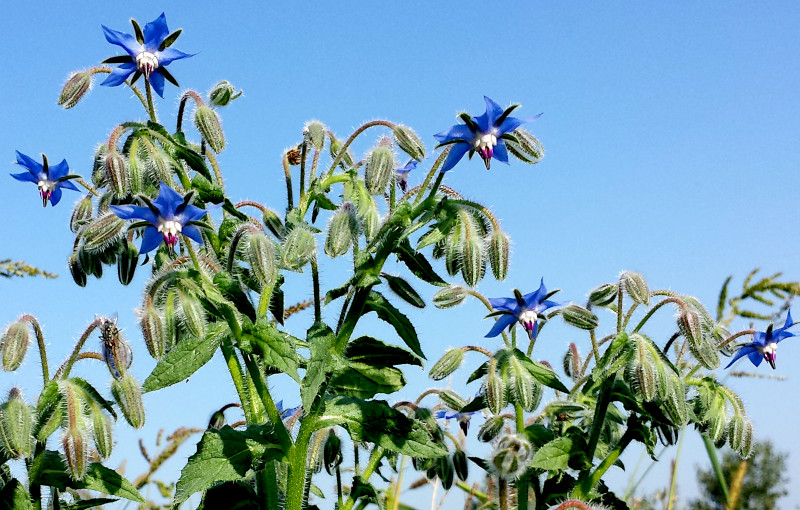Wise Mind Herbs
Evidence-based Herbal Healing
The information on this page has been prepared with reference to published scientific literature, not by a medically qualified expert. It is not medical advice. Any decision to use a supplement or herb-based product is your responsibility. Consult a suitably qualified medical professional, especially if you have underlying conditions. Remember, nothing is for everyone, and not everything sold is what it claims to be. Some things work for some people, some of the time.
Borage - Borago officinalis
Borage (Borago officinalis L.), also known as starflower, bee bread, or bee fodder, is a Mediterranean herb from the Boraginaceae family that has been used traditionally for various medicinal purposes. This review examines the scientific evidence behind its reported health benefits, appropriate dosages, and potential side effects based on peer-reviewed literature.

Common and Botanical Names
Borago officinalis L. is the accepted botanical name. Common names include borage, starflower, bee bread, and bee fodder. It should not be confused with Echium plantagineum (Patterson's curse), Trachystemon orientalis (Abraham-Isaac-Jacob), or Anchusa officinalis (common bugloss), which are different plants in the same Boraginaceae family that may sometimes be mistakenly identified as borage.
Active Compounds
The main bioactive components in borage include gamma-linolenic acid (GLA) from the seed oil, pyrrolizidine alkaloids (PAs), rosmarinic acid, and various polyphenols, flavonoids, and terpenoids. Borage seed oil typically contains 20-26% GLA, making it one of the richest natural sources of this omega-6 fatty acid.
Evidence-Based Health Benefits
- Anti-inflammatory effects: Borage seed oil rich in GLA has demonstrated anti-inflammatory properties in several studies, particularly for rheumatoid arthritis and atopic dermatitis.
- Skin conditions: Clinical trials suggest improvements in skin barrier function and moisture retention in patients with atopic dermatitis when using borage oil supplements.
- Rheumatoid arthritis: Moderate evidence suggests GLA from borage oil may reduce joint pain and stiffness and decrease the need for conventional pain medications in some patients.
- Respiratory conditions: Limited evidence indicates potential benefits in asthma and cough, likely due to anti-inflammatory effects.
- Cardiovascular health: Preliminary studies suggest possible benefits for reducing blood pressure and improving lipid profiles, though evidence remains limited.
- Hormonal balance: Some evidence suggests borage may help with premenstrual syndrome and menopausal symptoms, though more research is needed.
Recommended Dosages
- Borage seed oil: 1-3g daily, standardized to contain 20-26% GLA (providing approximately 200-700mg of GLA daily).
- For atopic dermatitis: 2-3g of borage oil daily for at least 8-12 weeks.
- For rheumatoid arthritis: 1.4-2.8g of borage oil daily, providing approximately 300-600mg GLA.
- Leaf preparations (tea): 2-4g of dried herb infused in hot water, up to three times daily.
Most clinical studies have used standardized extracts with defined amounts of GLA rather than whole plant preparations. The efficacy of traditional preparations like teas is less well-documented in scientific literature.
Side Effects and Safety Concerns
- Pyrrolizidine alkaloids: Borage contains pyrrolizidine alkaloids (PAs) which have hepatotoxic, carcinogenic, and genotoxic potential. While these are mainly concentrated in the leaves and stems, they can be present in small amounts in seed oil.
- Liver toxicity: Long-term use of PA-containing preparations may potentially cause veno-occlusive disease and liver damage.
- Anticoagulant effects: GLA may enhance the effects of blood-thinning medications.
- Pregnancy concerns: Use during pregnancy is contraindicated due to potential risks from PAs.
- Digestive issues: Some individuals report mild gastrointestinal discomfort.
High-Dose Studies and Knowledge Gaps
Studies investigating doses significantly above the recommended therapeutic range (>3g borage oil daily) are limited. No studies have systematically evaluated extremely high doses due to safety concerns regarding PA content.
Significant knowledge gaps include: long-term safety profiles beyond 6 months of use; comprehensive pharmacokinetic studies; potential interactions with medications; and standardized preparation methods to minimize PA content while maintaining therapeutic compounds.
Commercial Pharmaceutical Products
Most commercial products containing borage are classified as dietary supplements rather than pharmaceutical drugs in many countries, including the United States.
References
Chen, P. Y., Liu, C. S., Lin, L. Y., Lin, Y. C., Sun, H. L., Li, C. C., ... & Liu, K. L. (2016). Borage oil supplementation decreases lipopolysaccharide-induced inflammation and skeletal muscle wasting in mice. RSC Advances, 6(102), 100174-100185.
EFSA Panel on Contaminants in the Food Chain (CONTAM), Knutsen, H. K., Alexander, J., Barregård, L., Bignami, M., Brüschweiler, B., ... & Binaglia, M. (2017). Risks for human health related to the presence of pyrrolizidine alkaloids in honey, tea, herbal infusions and food supplements. EFSA Journal, 15(7), e04908.
Gama, C.R.B., Lasmar, R., Gama, G.F., Oliveira, L., Naliato, E.D.O., Ribeiro, M.G., Fonseca, A.D.S.D. and Geller, M., 2014. Premenstrual syndrome: clinical assessment of treatment outcomes following Borago officinalis extract therapy.
Mirsadraee, M., Moghaddam, S. K., Saeedi, P., & Ghaffari, S. (2016). Effect of Borago officinalis extract on moderate persistent asthma: a phase two randomized, double blind, placebo-controlled clinical trial. Tanaffos, 15(3), 168.
Singh, S., Singh, T. G., Mahajan, K., & Dhiman, S. (2020). Medicinal plants used against various inflammatory biomarkers for the management of rheumatoid arthritis. Journal of Pharmacy and Pharmacology, 72(10), 1306-1327.
Tasset, I., Fernández Bedmar, Z. N., Lozano Baena, M. D., Campos-Sánchez, J., Haro Bailón, A. D., Muñoz Serrano, A., & Alonso Moraga, Á. (2013). Protective Effect of Borage Seed Oil and Gamma Linolenic Acid on DNA: In Vivo and In Vitro Studies.
Tewari, D., Bawari, S., Patni, P., & Sah, A. N. (2019). Borage (Borago officinalis L.). In Nonvitamin and Nonmineral Nutritional Supplements (pp. 165-170). Academic Press.